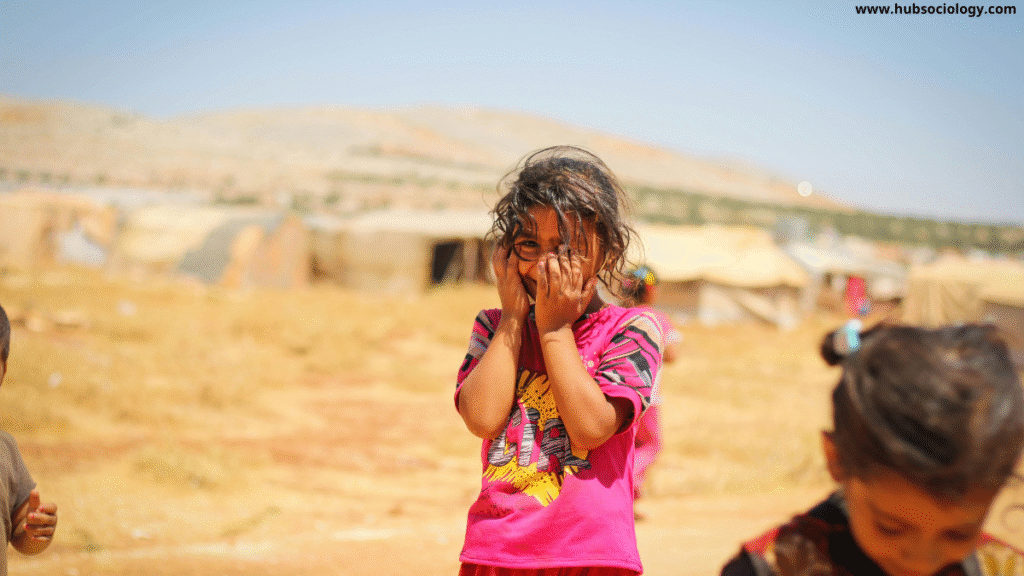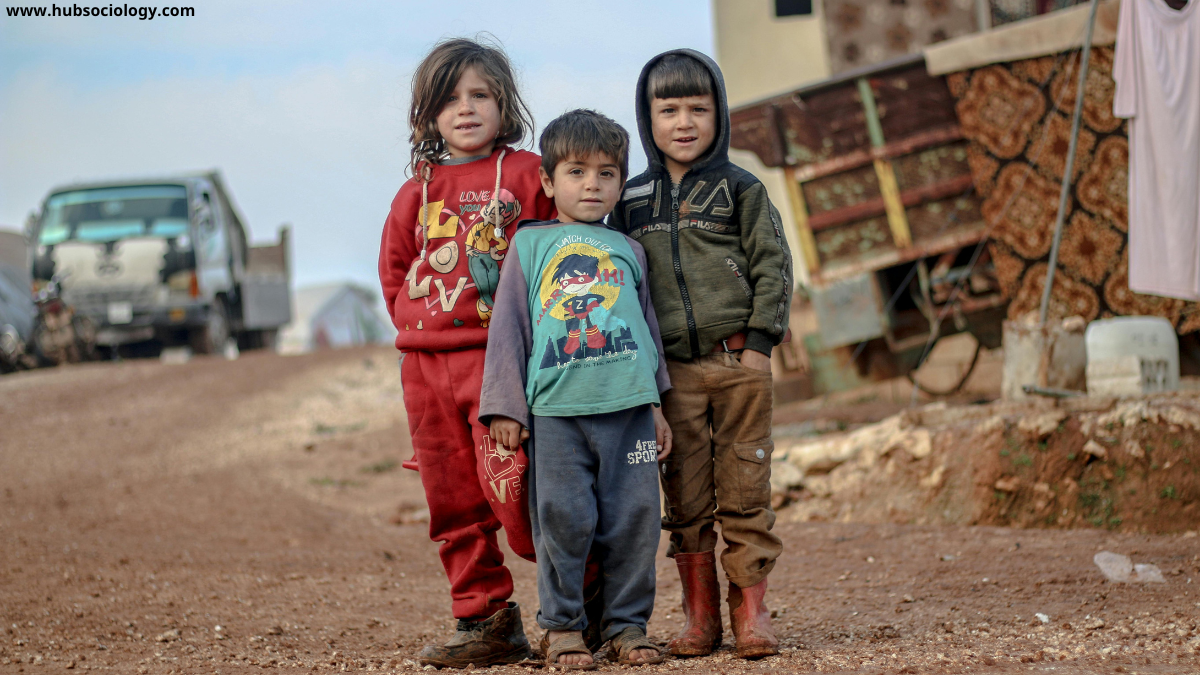Introduction on Meaning and Types of Migration
Migration has been one of the most significant social processes shaping human societies throughout history. From ancient nomadic tribes moving in search of food and shelter to contemporary global flows of labor, migration has transformed cultures, economies, and social structures. In sociology, migration is studied not merely as a geographical movement of people but as a complex phenomenon that has profound implications for identity, social relations, and structural changes within society.
This article examines the Meaning and Types of Migration; explores its different types from a sociological standpoint, highlighting its multifaceted nature and consequences.

Table of Contents
Meaning of Migration
Migration can be defined as the movement of individuals or groups from one geographical location to another, either temporarily or permanently, with the intention of settling, working, or integrating into a new community. Unlike mere physical mobility such as tourism or commuting, migration implies a degree of permanence or semi-permanence in the new location.
From a sociological perspective, migration is not only about movement across space but also about the reorganization of social life. It involves adaptation to new social environments, interaction with host communities, and the potential reshaping of cultural and economic relations. Migration often reflects larger structural factors such as economic inequality, political instability, demographic changes, or global processes like urbanization and globalization.
Sociologists emphasize that migration is a social process influenced by both “push” and “pull” factors.
- Push factors are conditions that drive people to leave their place of origin, such as poverty, unemployment, natural disasters, wars, or lack of opportunities.
- Pull factors are conditions in the destination area that attract migrants, such as better employment, education, safety, or political freedom.
Migration, therefore, is not just a matter of personal choice but a reflection of broader social, economic and political structures.
Types of Migration
Migration takes various forms depending on distance, duration, motivation, and social context. Below are the major types of migration studied in sociology:

1. Internal and International Migration
- Internal Migration refers to the movement of people within the boundaries of a country. For example, rural-to-urban migration in India, where individuals move to cities in search of jobs, is a classic case.
- International Migration involves movement across national boundaries. Migrants may move permanently to another country (immigration/emigration) or temporarily for work and study. The Indian diaspora in the United States, Gulf countries, and Europe exemplifies international migration.
Internal migration often reshapes urbanization, labor markets, and family structures, while international migration creates issues of citizenship, identity, and multiculturalism.
2. Voluntary and Forced Migration
- Voluntary Migration occurs when people move out of their own choice, usually for better opportunities in education, work, or lifestyle. It reflects agency and individual decision-making.
- Forced Migration occurs when individuals are compelled to leave their homes due to wars, natural disasters, political persecution, or development projects. Refugees from conflict zones or people displaced by large dams and industrial projects are examples.
Forced migration often results in social dislocation, trauma, and long-term challenges for integration.
3. Rural-Urban, Urban-Rural, and Urban-Urban Migration
- Rural-Urban Migration: A common pattern in developing societies, where people leave villages to work in cities. This leads to urban growth but also strains infrastructure, creates slums, and alters traditional rural communities.
- Urban-Rural Migration: Less common but observed in cases where people return to rural areas for retirement, agriculture, or due to high urban living costs.
- Urban-Urban Migration: Refers to movement between cities, often due to employment transfers, education, or lifestyle choices.
These flows highlight the role of industrialization, modernization, and urban policies in shaping migration.
4. Temporary, Seasonal, and Permanent Migration
- Temporary Migration: When people move for a limited period, such as students studying abroad or employees on contracts.
- Seasonal Migration: A type of temporary migration tied to agricultural cycles, festivals, or tourism. For example, laborers moving to cities during harvest seasons.
- Permanent Migration: When individuals or families relocate with no intention of returning to their place of origin, settling permanently in the new location.
Sociologically, these types affect family life, gender roles, and community ties differently. Seasonal migration, for instance, may disrupt education and health care for children.
5. Labor Migration
Labor migration is one of the most significant forms of migration in modern times. It refers to the movement of people for employment opportunities.
- Internal labor migration is common in countries with uneven development, where people from backward regions move to industrial hubs.
- International labor migration includes both skilled professionals (doctors, engineers, IT specialists) and unskilled workers (construction laborers, domestic workers).
Labor migration is linked to globalization, remittances, and the international division of labor. It also raises questions of labor rights, exploitation, and brain drain.
6. Refugee and Asylum-Seeker Migration
Refugees are people forced to leave their home country due to conflict, persecution, or environmental crises. Asylum-seekers request international protection, often fleeing human rights violations.
These forms of migration bring sociological attention to issues of human rights, nationalism, identity, and integration in host countries.

7. Return Migration
Return migration occurs when individuals go back to their place of origin after spending time elsewhere. It may be voluntary, such as retired migrants returning home, or forced, due to deportation or inability to adapt. Return migration often leads to the transfer of new skills, ideas, and resources to the home community, but may also create reintegration challenges.
8. Transnational Migration
In the era of globalization, transnational migration has become prominent. Migrants maintain ties with both home and host countries simultaneously. For example, they send remittances, engage in cultural exchanges, and participate in politics of both nations. This creates transnational identities and networks that reshape the meaning of citizenship and belonging.
Sociological Implications on Meaning and Types of Migration
Migration is more than movement; it reshapes the very fabric of society. Its consequences can be understood at multiple levels:
- Cultural Change: Migration leads to cultural diffusion, hybridity, and sometimes cultural conflicts. Multicultural societies emerge as migrants bring diverse traditions and practices.
- Social Stratification: Migrants often occupy lower positions in the labor market, leading to new forms of inequality. In some contexts, migration can also enable upward mobility and the creation of a middle class.
- Family and Gender Relations: Migration alters family structures. For instance, male-dominated labor migration leaves women with increased household responsibilities. In other cases, women migrate independently, challenging traditional gender norms.
- Urbanization: Rural-to-urban migration fuels city growth, but also leads to overcrowding, slums, and environmental stress.
- Identity and Integration: Migrants negotiate multiple identities in host societies. Issues of assimilation, multiculturalism, and discrimination are central to their experiences.
- Global Interdependence: Migration connects economies through remittances and labor flows, making societies interdependent in new ways.
Conclusion on Meaning and Types of Migration
Migration is a fundamental process shaping human societies, driven by economic, political, cultural, and environmental factors. From internal rural-urban migration to transnational flows, it takes diverse forms that carry profound social implications. Sociologists view migration not just as a demographic phenomenon but as a transformative social process affecting families, communities, and nations. By studying the meaning and types of migration, sociology reveals how movement across space is deeply intertwined with issues of identity, inequality, globalization, and social change.
Do you like this this Article ? You Can follow as on :-
Facebook – https://www.facebook.com/hubsociology
Whatsapp Channel – https://whatsapp.com/channel/0029Vb6D8vGKWEKpJpu5QP0O
Gmail – hubsociology@gmail.com
Topic Related Questions on Meaning and Types of Migration
5 Marks Questions on Meaning and Types of Migration (Short Answer Type)
- Define migration from a sociological perspective.
- Distinguish between internal and international migration.
- What is the difference between voluntary and forced migration?
- Give two examples of seasonal migration.
- State two major push and pull factors of migration.
10 Marks Questions on Meaning and Types of Migration (Medium Answer Type)
- Explain the difference between rural-urban, urban-rural, and urban-urban migration with examples.
- Discuss the sociological significance of labor migration in developing countries.
- How does migration affect family structures and gender roles?
- Write short notes on: (a) Return Migration, (b) Transnational Migration.
- Analyze the role of migration in the process of urbanization.
15 Marks Questions on Meaning and Types of Migration (Long Answer/Essay Type)
- Critically examine the different types of migration and their sociological implications.
- Discuss how push and pull factors shape the patterns of migration in contemporary society.
- Explain the consequences of international migration on culture, identity, and social integration.
- Evaluate the impact of forced migration on refugees and host societies from a sociological viewpoint.
- Examine the role of globalization in reshaping the meaning and types of migration in the 21st century.
